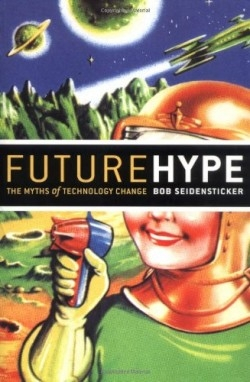Future Hype
The Myths of Technology Change
According to the author, the Internet isn’t that big a deal. A former project manager at Microsoft, Seidensticker says the popular perception that modern technology is profoundly changing our lives is exaggerated and out of step with reality. He asserts that it’s human nature for people to overestimate the importance of new inventions, such as the Internet, while underestimating those they’ve grown up with—the car, the telephone, electricity. He cites dozens of older technologies, such as the telegraph and the railroad, as having had a far greater impact on human lives than the Internet. For a truly serious collision between technology and society, Seidensticker points to the Industrial Revolution and Great Britain during the first half of the nineteenth century.
While not new, Seidensticker’s hypothesis is convincing, provocative, and well supported with historical and contemporary examples. In Part I, he postulates nine myths about high tech—“change is exponential,” “technology is inevitable,” “the Internet changes everything” —and proceeds to deflate them systematically and perceptively. Discussing the myth of “the rising tide of valuable information,” Seidensticker derides it as a “flood of decreasing reliability” and argues that there’s a difference between information and knowledge. He suggests that the most important information has always had an outlet and that the flow of new information had no outlet in the past because it was not, and is not, very important. As an example of the wrong-headedness of the perception that the Internet changes everything, Seidensticker observes that e-commerce accounted for only two percent of the $3.6 trillion of total retail sales in 2004. He argues that rather than providing a new paradigm, the Internet merely offers a convenient alternative to existing facilities, such as stores and libraries.
Part II of the book, which focuses on the constancy of technological change, is less successful, essentially restating the argument that this is not the first generation to be astounded by technology, not the first to rearrange whole lifestyles to accommodate it. Seidensticker observes that only those people born before a technology becomes pervasive even think of it as technology. He concludes with some self-evident pointers for applying a clearer view of technology—avoid technology infatuation, resist alarmist claims that change is faster and faster. While not the first to throw a wet blanket on the enthusiastic sparks generated by new technology, Seidensticker, with his cachet as a former Microsoft insider and his shrewd and carefully reasoned presentation, will provoke discussion.
Reviewed by
Rob Mitchell
Disclosure: This article is not an endorsement, but a review. The publisher of this book provided free copies of the book to have their book reviewed by a professional reviewer. No fee was paid by the publisher for this review. Foreword Reviews only recommends books that we love. Foreword Magazine, Inc. is disclosing this in accordance with the Federal Trade Commission’s 16 CFR, Part 255.

